
Dendrobium is a genus of mostly epiphytic and lithophytic orchids in the family Orchidaceae. It is a very large genus, containing more than 1,800 species that are found in diverse habitats throughout much of south, east and southeast Asia, including China, Japan, India, the Philippines, Indonesia, Australia, New Guinea, Vietnam and many of the islands of the Pacific. Orchids in this genus have roots that creep over the surface of trees or rocks, rarely having their roots in soil. Up to six leaves develop in a tuft at the tip of a shoot and from one to a large number of flowers are arranged along an unbranched flowering stem. Several attempts have been made to separate Dendrobium into smaller genera, but most have not been accepted by the World Checklist of Selected Plant Families.

Dendrobium crumenatum, commonly called pigeon orchid, or 木石斛 is an epiphytic orchid in the family Orchidaceae and is native to Asia, Southeast Asia, New Guinea and Christmas Island. It has two rows on leaves along its pseudobulb and relatively large but short-lived, strongly scented white flowers. It usually grows in exposed positions in lowland rainforest and coastal scrub.
Palaquium mindanaense is a species of plant in the family Sapotaceae. It is endemic to the Philippines, where it is confined to Mindanao.
David Burke was one of the most widely travelled plant collectors, who was sent by James Veitch & Sons to collect plants in British Guiana, Burma and Colombia. In his later life, Burke became rather eccentric, preferring the privations of life away from his native England.

The Visayas State University is a university located in the city of Baybay, province of Leyte, Philippines. The five-campus VSU system has eight colleges, three institutes and one school. Located in the main campus are the College of Veterinary Medicine, College of Engineering, College of Education, College of Forestry and Environmental Science, College of Arts and Science, College of Nursing, College of Management and Economics,College of Agriculture and Food Sciences, Institute of Strategic Research and Development Studies, and the Graduate School and Special Programs.

Dendrobium anosmum is a species of epiphytic orchid. It is widespread across Southeast Asia from Sri Lanka to New Guinea, including Indochina, Indonesia, the Philippines, etc. In 1839, the scented variety was first discovered by Lindley in the Philippines and named Dendrobium macrophyllum, which later on considered as homonym of other species. Six years later, the unscented variety was discovered again in the Philippines, hence, the botanical nomenclature until to this date.
Dendrobium platycaulon is a species of orchid native to Borneo and the Philippines.
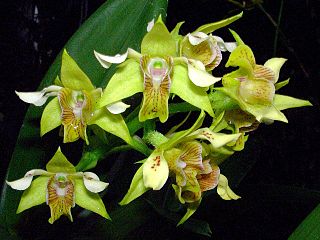
Dendrobium macrophyllum, commonly known as the large-leaved dendrobium or pastor's orchid, is a species of Orchid.

Dendrobium secundum, also known as the toothbrush orchid, is a species of flowering plant in the genus Dendrobium of the family Orchidaceae. The common name refers to the fact that all the flowers are on the same side of the stem, much like the bristles all on one side of a toothbrush.
"Blue Orchid" is a song by the White Stripes.

Dendrobium philippinense is a species of orchid in the genus Dendrobium that is native to the Philippines, for which it is named, and also to the Island of Guam in the Micronesia.
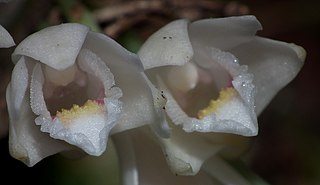
Dendrobium milaniae is flower of the Orchid family found in Leyte, Visayas in the Philippines, where it is found growing as an epiphyte above bodies of water at elevations up to 600 metres. The flower grows to approximately 1.5 centimetres (0.59 in). The plant is semi-pendulous and sympodial. Pseudobulbs are 10 cm by 2 cm; 3 to 6 green lanceolate leaves are present on the top third of the pseudobulb. Hans Fessel and Emil Lückel named this species in 1996 in Die Orchidee.

Dendrobium sanderae is a member of the family Orchidaceae endemic to the Philippines. It is found in the Montane Regions of Central Luzon, the Luzon tropical pine forests, north or the Philippines an epiphyte that grows on the trunks of pine trees in pine forest located at altitudes of about 1000 to 1600 meters. This epiphyte of medium size has erect, slightly thick below the middle pseudobulbs; racemes are short for dendrobiums and inflorescences are present during the dry season. Sepals and petals are white while the lip is white with a green or yellow center.
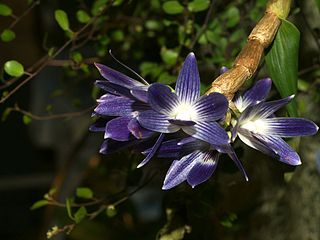
Dendrobium victoriae-reginae is a member of the family Orchidaceae endemic to the Philippines.
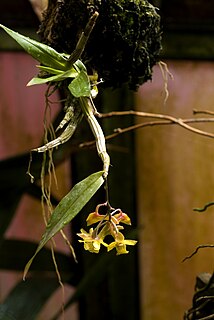
Dendrobium guerreroi, or Guerrero's dendrobium, is a member of the family Orchidaceae endemic to the Philippines. It was named in honor of Mr. Guerrero, a Filipino orchid collector in the 1900s. This species is a small to medium to large sized, warm growing epiphyte with thin descendant, clumping pseudobulbs that rarely branch and carry many, unsubdivided, pointed fleshy leaves. Flowers are 3 centimeters and are yellow with light orange labia.

Dendrobium bullenianum is a member of the family Orchidaceae found in the Philippines and Vietnam. It is named in honor of Mr. Bullen, orchid cultivator with Low & Co.'s nursery, who was first in Britain get this species to flower in cultivation. It is pendulous and sympodial with 1 meter long pseudobulbs of 1.5 cm thickness and deciduous leaves of 10 cm by 1.5 cm. Heinrich Gustav Reichenbach was the first to describe this species in 1862 in Botanische Zeitung. It is found as an epiphyte in elevations up to 1,000 metres in Luzon and Mindoro in the Philippines.

Dendrobium ceraula''' is a species of orchid endemic to the island of Luzon in the Philippines.

Dendrobium plicatile is an orchid species of Asia. It was formerly treated as Flickingeria fimbriata in the genus Flickingeria.
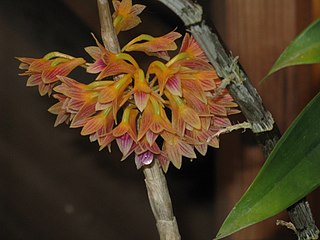
Dendrobium × usitae, Usita's dendrobium, is a species of epiphytic orchid endemic to the Philippines. It is a natural hybrid between D. bullenianum and D. goldschmidtianum and can be easily distinguished from both species by its purplish orange flower. The specific epithet honors Villamor T. Usita of Quezon City, who discovered the species from Calayan, one of the five major islands of Babuyan archipelago. In its native habitat, the plant grows hanging on trees at an elevation of 500 to 700 meters above sea level alongside with its parent species. The pendulous stem of D. × usitae can reach a length of 60 centimeters.














